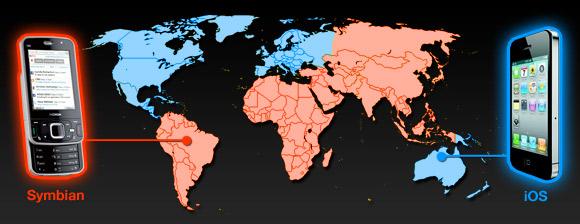According to IDC figures reported by the Sydney Morning Herald, Nokia remains the top mobile maker overall, with a 37.6 percent share of all phones sold.
However, Nokia's loss of its leadership role in smartphones is notable for two reasons. First, sophisticated smartphones account for most of the profits in the mobile handset industry, and Nokia's Symbian has fallen behind in the software technology needed to deliver compelling smartphone products.
Secondly, Australia represents a significant foreign market that Nokia has comfortably held under its control since taking the top selling smartphone title from Palm in 2002.
Nokia has never had much of a presence in the US, where Apple initially shipped the iPhone. However, as Apple expanded to take leading positions in Europe and Japan as the most popular phone model, Symbian has retreated into smaller markets.
Web statistics published last week by StatCounter indicate Apple's iOS has already taken the lead in North America, Europe and Australia as the most popular devices to browse the web.
Android advancing from the rear
Behind Apple's iOS iPhone and Nokia's Symbian smartphones, all of the manufacturers using Google's Android OS together amount to a collective share of 21 percent of the Australian smartphone market. That share is growing fast, up from only 2.1 percent at the beginning of the year.
"It's looking like next year it's going to be close between Android and Apple," IDC Australia analyst Mark Novosel said in the report, "but I would be inclined to say that Apple will keep its lead, although we have been under pretty much every quarter with our Android forecast so anything really is possible at this stage."
Smartphone sales in Australia have grown by 67 percent over the last year, and now account for 60 percent of all mobiles sold.
"2011 will be a critical year in the Australian market, Android will continue its strong upward trend, with Apple's iOS leading the charge," Novosel concluded.
 Daniel Eran Dilger
Daniel Eran Dilger







-m.jpg)






 Christine McKee
Christine McKee
 Marko Zivkovic
Marko Zivkovic
 Mike Wuerthele
Mike Wuerthele

 Amber Neely
Amber Neely
 Sponsored Content
Sponsored Content
 Wesley Hilliard
Wesley Hilliard










16 Comments
I would say that the Australian market is significant psychologically, but small, with only about 21 million people. As far as I know, apple is in 89 countries, at least from last I looked. That leaves about another 90, though most of those are pretty small. It seems as though Nokia is in about all of them. I don't know about Android.
Android will come out on top eventually as they are on more devices, exposed to more eyes and more salespeople, thus more sales.
I predict a eventual backlash against the iPhone coming from salespeople at locations other than at Apple Stores, as Android phone makers offer better sales incentives.
It's ok though, Steve and Eric planned this all out in advance, someone had to be the larger "open" platform and Steve surely didn't want Ballmer to have it.
I was in a Vodafone? store in Chatswood the other day for a few hours (USB modem problems) and about 6 people came in asking for iPhone 4's. The store only gets in (i was told) about 2 per week, so supply here must be totally non existent. Customers either walked out, or one mother tried to get her 'child' to have something different. So once supply problems, or better allocation is reached, these figures should be even better.
I wonder what the numbers are over the ditch, here in NZ?
Android will come out on top eventually as they are on more devices, exposed to more eyes and more salespeople, thus more sales.
I predict a eventual backlash against the iPhone coming from salespeople at locations other than at Apple Stores, as Android phone makers offer better sales incentives.
It's ok though, Steve and Eric planned this all out in advance, someone had to be the larger "open" platform and Steve surely didn't want Ballmer to have it.
And your somewhat confusing post has something to do with the iPhone's dominance in Oz?
Regardless of our 'insignificant' head count, the numbers show what would happen in the US when the iPhone can be purchased from Verizon, T mobile and others.
If you don't have an iPhone, in Australia, you're in the minority.